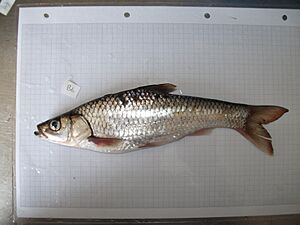Enteromius litamba facts for kids
Quick facts for kids Enteromius litamba |
|
|---|---|
| Conservation status | |
| Scientific classification | |
| Synonyms | |
|
The Enteromius litamba is a fascinating type of ray-finned fish. It belongs to the Cyprinidae family, which includes carps and minnows. For a long time, scientists called it Barbus litamba. But now, many experts think it belongs in a different group, either Labeobarbus (yellowfish) or Enteromius. This is because scientists are always learning more about how living things are related! It's also thought to have six sets of chromosomes, like other yellowfish.
Contents
Where Does the Litamba Fish Live?
The E. litamba lives in freshwater. Its natural homes are rivers and lakes. You can only find this fish in Lake Malawi and the rivers that flow into it. This lake is located in Malawi, Mozambique, and Tanzania. When a species is found only in one specific area, it is called endemic.
What Does the Litamba Fish Look Like and How Does It Live?
The E. litamba is a large fish. The biggest ones can grow up to about 45 centimeters (18 inches) long. However, most of them are usually smaller.
Young litamba fish like to live in groups, called shoals. They prefer areas with sandy bottoms. As they grow older, adult litamba fish also live in shoals. They swim in open waters, looking for food. Even though they live in open water, they often stay closer to the shore.
What Does the Litamba Fish Eat?
These fish are predators. This means they hunt and eat other animals. Their main food is smaller fish. When they are young, they also eat insects.
Reproduction and Life Cycle
Scientists don't know much about where E. litamba lay their eggs. This is called their spawning grounds. However, many fish related to them move from lakes into rivers to lay their eggs. This type of movement is called potadromous migration. It is likely that E. litamba does something similar.
Is the Litamba Fish Endangered?
People catch E. litamba for food using scoop nets. But it's not as common as other "barb" fish in Lake Malawi. So, it's mostly important for local fishing. The good news is that it's not rare. Because it lives in a wide area, the IUCN (International Union for Conservation of Nature) does not consider it a threatened species. However, like with all large fish, Overfishing could become a problem if too many are caught.



